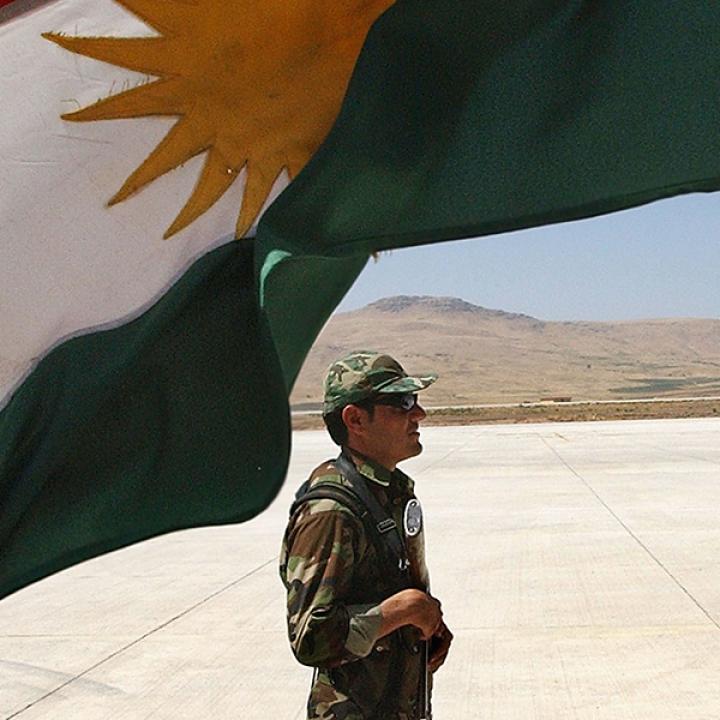
- Policy Analysis
- Fikra Forum
The PKK in Sinjar at the Center of Many Conflicts

July 5, 2017
Iran is creating and reinforcing power centers for its allied forces by implementing its policies across a geographic area that extends from the western borders of Iraq to the shores of the Mediterranean. It is also creating provisional Shiite cells in Sunni Arab regions by employing paramilitary Shiite groups and other forces that serve Iranian interests. One of those groups is the Kurdistan Workers’ Party (PKK).
In 2014, the Islamic State took control over Sinjar, which was under Peshmerga control until their retreat on August 3, 2014. While ISIS approached the city, the Peshmerga left its citizens vulnerable to horrific abuses, according to several international organizations.
PKK fighters mobilized to save the Yazidis by moving them to camps in regions under their control in Syria or to the mountainous regions north of Sinjar. The Peshmerga’s retreat from Sinjar left a serious impact on the Yazidis’ confidence in the Peshmerga’s ability to protect them. Thus, the PKK organized a group of Yazidi volunteers, the Protection Forces of Shingal (Sinjar). The PKK also exploited the internal conflicts within Yazidi society and the gap between a large segment of Yazidis and Arab populations of Iraq and Kurdistan province. While based in the Qandil Mountains, the PKK found an opportunity to take control over Sinjar, exploiting the Yazidis’ dissatisfaction with the Peshmerga forces.
The PMUs and PKK became intertwined shortly before the battle to recapture Mosul on October 17, 2016, agreeing to integrate PKK soldiers among PMU ranks to battle ISIS. The PMU leadership also arranged semi-ongoing meetings between the IRGC and the PKK to discuss providing military reinforcements to PKK fighters. Their goal was to secure the road linking Iran’s western borders to Syria via Sinjar Province in the Nineveh Governorate. The PKK then adopted Iranian, Iraqi, and PMU leadership positions opposed to Kurdish independence. They also rejected holding a referendum on the fate of the Kurdistan region.
The PKK’s position on the region’s independence is controversial. Future conflicts are likely between the Peshmerga and the PMUs over the disputed territories. Peshmerga forces recaptured territory in Sinjar with cooperation from the PKK in mid-November 2014. Since then, the PKK has refused to withdraw from the city in compliance with the demands of the KRG, which likewise refuses to hand it over to any other authority, and plans to make it a governorate of the Kurdistan Region. The Protection Forces of Shingal are accusing the KRG of attempting to “occupy Sinjar by agreement with the Turkish government.” Meanwhile, the Kurdistan Democratic Party believes that the PKK is an intruder in Sinjar Province.
With all of the disputes between the PKK and the Peshmerga, the Kurdistan Regional Government has avoided direct confrontation with the PKK, whose fighters boast impressive military experience, and which enjoys a popular base of Kurdish support in Iraq, Syria, Turkey, and Iran. To establish trust, the KRG announced a pledge to protect the Yazidis and rebuild the areas destroyed during the Islamic State’s capture of Sinjar on August 3, 2014, and the city’s recapture on November 13, 2015. The pledge’s language also used the term “Yazidi Kurds,” formally – for the KRG – making Yazidis a part of the Kurdish people.
However, the PKK may not consider withdrawing from Sinjar due to its importance as a launching point for conducting operations in Turkish cities and as a geographic extension connecting the regions under its control in northern Syria, which were subjected to its own democratic self-governing system four years ago. Sinjar also represents an important ground link between its fighters in Sinjar, the PKK’s main fortification in the Qandil Mountains, and the areas held by the PKK-linked People’s Protection Units in Syria.
Giving the Yazidis some form of self-government will be essential to breaking them away from the PKK, as well as providing them protection from future ISIS attacks originating from the desert areas in northwest Anbar near Sinjar, which are likely to come after Mosul’s recapture. To secure their future during the stage after the battle to retake Mosul, leaders of the Yazidi community believe it necessary that the Nineveh governorate is split into two new governorates: one for Christians, Shabak, etc.; and the other in Sinjar specifically for Yazidis.
It would also be helpful to reassure the PKK by ensuring the flow of goods and supplies to regions under its control, by opening safe land corridors between said regions in the Qandil Mountains and cities of the Kurdistan Region, Baghdad, and Nineveh governorate, in exchange for its retreat from Sinjar. The PKK uses this city for its trade routes to relieve pressure on the regions under its control in the Qandil Mountains, where they impose their own system of government on 658 villages in the Iraqi Kurdistan Region.
Meanwhile, Turkey has encountered twin threats from the PKK and ISIS in Nineveh. Even if ISIS fighters are no longer found in the governorate’s cities, the PKK will continue to pose a danger to it now that its area of control has expanded from the Qandil Mountains to Sinjar and the areas surrounding it, connecting it to the northern and northeastern portions under its control in Syria alongside the Turkish border. Likewise, the increasing Iranian presence through its alliances with the PMU and PKK is the third largest long-term threat to Turkey’s interest and national security in northern Iraq, behind the two essential threats posed by the PKK and ISIS.


